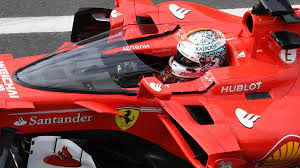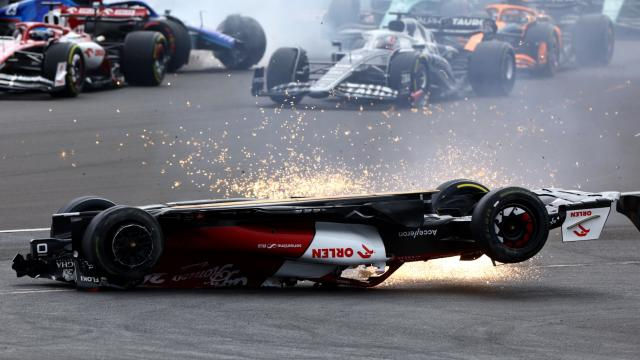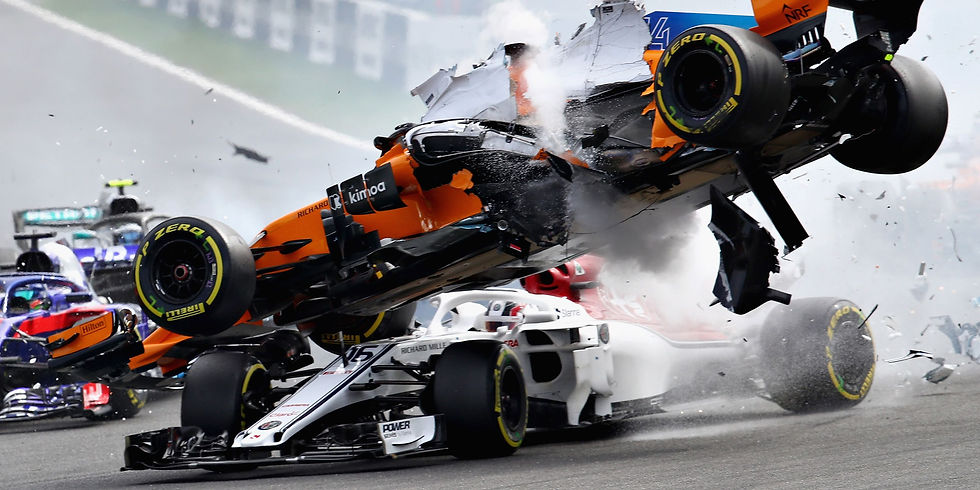What if the halo was never added?
- mallikarull
- May 21, 2023
- 4 min read
Updated: Aug 2, 2023
First proposed by Mercedes after the FIA began its research into rudimentary front roll cages, the halo was introduces in 2018. The decision was made based on the halo offering “the best overall safety performance”, according to the FIA.

The decision to include the halo was met with many conflicting opinions on the matter, but since proven to be one of the most crucial changes to come in recent years.
A call for safety
A focus on cockpit protection increased in 2009 following the death of Henry Surtees, son of former world champion John Surtees. Henry was killed by a loose wheel during a Formula 2 race. Just over a week later, Felipe Massa faces life-threatening injuries after a spring hit his head during a practice session at the Hungarian Grand Prix.
With the FIA beginning heavy research to improve drivers’ safety, the attention was brought back to drivers’ safety after the fatal collision between Jules Bianchi and a recovery vehicle during the 2014 Japanese Grand Prix, although an investigation following the incident found that improved cockpit protection would have no impact on the injuries Bianchi faced.
Focus on driver safety was not only a key topic in F1, but in other motorsport series too. In 2015 former F1 driver Justin Wilson was killed during a IndyCar race by a piece of debris flying from another car during a race. Further investigations found the dangers of an open cockpit, prompting the Grand Prix Drivers’ association to call for extra cockpit protection.
Development of the Halo
In 2017 a provisional halo was included in the technical regulations and conducted on track tests, which began in early 2016. However, many held concerns that the inclusion of the halo was being rushed without real world testing on different track conditions. F1 strategist group responded to the concerns by agreeing in July 2016 to postpone the introduction until 2018, opting to conduct further testing during Friday practice sessions.
Despite many successful tests in 2016, in a meeting with the strategy group it was decided that the FIA should shift their focus to a new device called the shield, which made its first track test at the British Grand Prix. The test session was cut short after Sebastian Vettel reported that the device distorted his vision through the curved windscreen, making him feel dizzy.

The FIA now running out of time to make a decision for 2018 cars, and the teams waiting for an answer, the ‘halo’ became the only viable option for the FIA and was included for 2018.
Few in favour of the Halo
Many drivers and people in the pitlane were against the inclusion on the halo, many of the reasons being due to do with reduced visibility, the added weight to the cars and aesthetics.
Some drivers who disagreed with decision included Max Verstappen, who commented on the appearance saying “when you look a the car and it’s ugly, F1 cars aren’t meant to be ugly”. Lewis Hamilton was another driver to share his disapproval with the decision saying “ultimately, it’s the drivers’ protection so we should have a choice individually”.
On the other side of the argument was Nico Rosberg and Sebastian Vettel, who believed the halo was a significant step forward. Rosberg agreed that the inclusion of the halo was a “huge step” forward and was “definitely needed”.
Times the Halo has proved its worth
2022 British Grand Prix
The halo showed its significance twice over the 2022 British Grand Prix weekend. In an F2 feature race, the halo saver Roy Nissany from serious injuries after a collision with Dennis Hauger, which saw Hauger’s car mount the top of Nissany’s car. Later that day, during the F1 race, the halo protected Zhou Guanyu in a nasty incident going into turn 1. The collision causing Zhou’s car to flip and end up in the catch-fencing. Zhou showed his gratitude after the incident in an interview, where he commented “the halo saved me today”, Zhou managing to walk away from the incident without any serious injuries.

Spa-Francorchamps 2018
During the race at the 2018 Belgium Grand Prix, the McLaren of Fernando Alonso launched over the Alfa Romeo of Charles Leclerc. Later investigations found that the halo saved Leclerc from injury, as Alonso’s front right wheel imparted a 54kN impact on Leclerc’s halo – 46% of the 125kN FIA-prescribed load requirement. Following the incident Leclerc shared “i have never been a fan of the halo but i have to say that i was very happy to have it over my head today”.

Sakhir, 2020
A huge test for the halo at the 2022 Sakir Grand Prix, Grosjean and Daniil Kvyat made contact at the start of the race, causing Grosjean to spear into the barrier. The impact caused his car split in half before being engulfed in a fireball. The halo allowed Grosjean to walk away from the crash only facing minor burns.





Comments